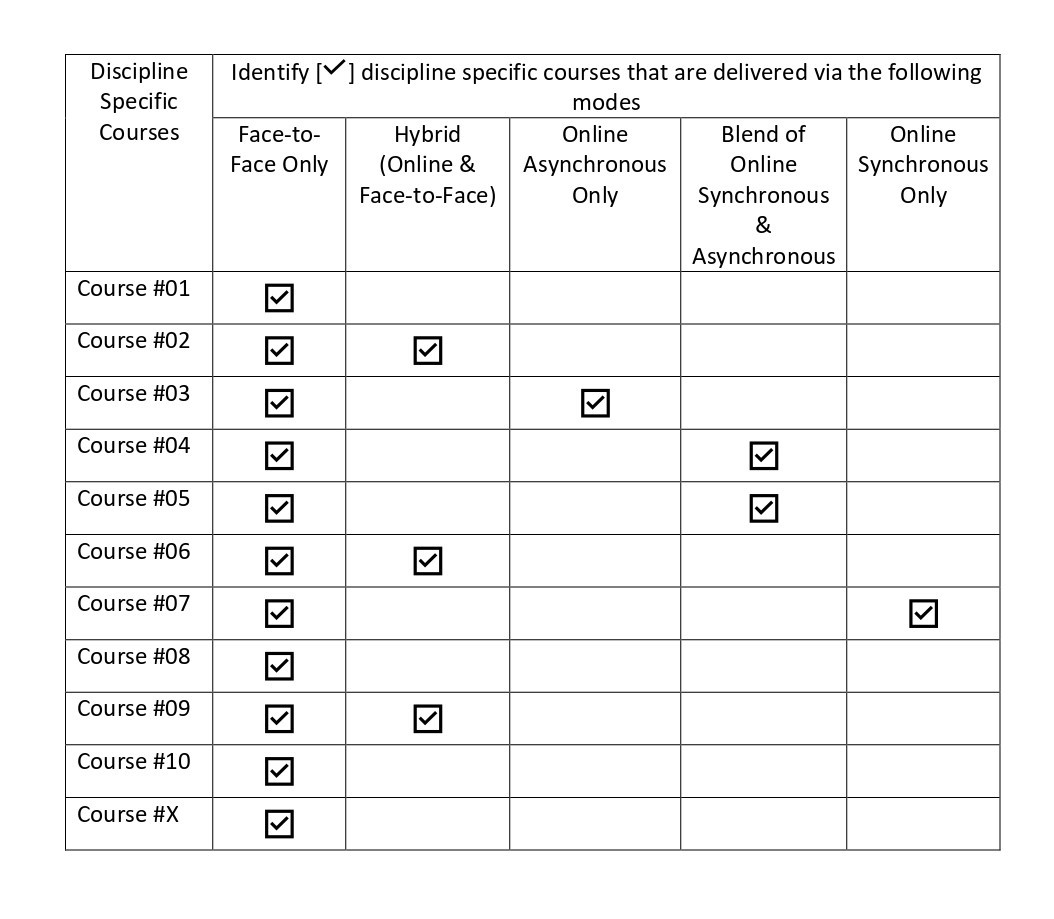4.3. Modes of Delivery
Working Definitions of Modes of Delivery
Learning activities and assessments should be designed to appropriately suit the mode the course will be delivered in, not all classroom-based activities suit online delivery formats. For example, when delivering a course in a fully online format, the instructor needs to intentionally develop learning activities to create social presence that is taken for granted in a typical face-to-face course. When designing a blended course delivered via both online and face-to-face formats, the alignment and integration of learning and assessment activities are not limited to learning outcomes but should support transition between modes and optimally utilize each learning space. The program review team is required to carry out a preliminary assessment of how the current delivery modes are aligned with the learning and assessment activities delivered in courses of the program.
See below working definitions to refer to these modalities in this guide.

Face-to-Face Learning where the course is delivered on campus, in class/lab setting, in-person, for students to meet the learning outcomes of the course.
Hybrid Learning that includes both on-campus, in-person, and online delivery of the curriculum, for students to meet the learning outcomes of the course.
Online Learning has multiple components.
Synchronous Online Learning is the educational term for live streaming. It occurs at a designated day and time to allow for real-time interaction between faculty and students. This may be used for short lectures, group discussions, office hours, and Q&A periods. If your course has synchronous components, students and faculty members need to be online during those scheduled days and times.
Asynchronous Online Learning is the educational term for aspects of learning that don’t need to be “live”. For any asynchronous components, students will be able to access the course material at any time, although they need to adhere to the deadlines for activities, assignments and overall timelines that the instructor provides.
Blend of Asynchronous & Synchronous Online the use of a blend of both asynchronous and synchronous online modalities, for students to meet learning outcomes of the course.
Evaluating your Current Delivery Modes, Student Needs & Capacity
Content in this section will assist the program review team to evaluate the current approaches taken to deliver courses via multiple modalities meets the needs of the student population and faculty capacity considerations.
After completing this section, the program review team may identify potential opportunities to deliver courses via alternative formats in the recommendations section of the self-study report.
Appendix 11: Current Modes of Delivery
4.3.1. Identify Current Modes of Delivery for Discipline Specific Courses of the Program.

The above analysis will help identify how current courses in the program are delivered via alternative formats.
4.3.2. Assess Student Demand for Alternative Delivery Formats
Consider developing custom questions to be included in the student survey to identify student preferences, student scheduling challenges, inability to get required courses, competing work and family demands, etc. in taking/offering courses through a variety of delivery modes. See survey development guide # 3.
Based on survey results, identify whether there is demand from students to deliver courses via a variety of delivery modes.
4.3.3 Waitlist Analysis for Your Current Courses
Based on waitlist data for discipline specific courses, identify courses that have a long waitlist, or unfulfilled spaces in the program. In the recommendations section (chapter 7), consider whether offering any of these high demand courses in an alternative delivery format potentially will solve the problem.
4.3.4 Faculty Interests to Deliver Courses in Alternative Formats
Also consider developing custom questions to be included in the faculty survey regarding interests among faculty members in your department who are willing to learn/pilot teaching courses in alternative formats.
Based on survey results, identify whether there is sufficient faculty capacity to deliver courses in alternative delivery modes.
4.3.5. Next Steps
Refer to the Self-Study Guide (KPU Program Review Guide Series #4) chapter 04, section 4.3 (Modes of delivery). Follow the instructions provided in that section.

